By Lauren Robinson
Laura Terry is not unfamiliar with breaking the rules.
That is, she is knowledgeable of the classic art and traditional methods of printmaking. But rather than strictly adhering to those methods, she is experimenting with techniques made possible using machinery in the Fay Jones School’s design shop. She shared those techniques in her printmaking class, which she taught for the second time this spring.
When Terry first taught the class, she mostly stuck to traditional printmaking. But this spring, she developed the course so students could learn both traditional and non-traditional printmaking. Several examples of the students’ work are on display in the Smart Lobby of Vol Walker Hall this summer.
“I’m interested in that hybrid between the way you would make a print or a plate by hand, and the way you could alter the plate through digital output,” said Terry, an associate professor of architecture. “Many of the images that were made this semester were made using both techniques.”
With traditional printmaking, an image is etched into a plate, which is then covered with ink, wiped, layered with a piece of paper and then run through a press. But Terry and her students use technology to slightly modify and enhance those steps. They use Photoshop computer software to create images that they then send to the laser cutter, which carves those images in to Plexiglas, copper or chipboard. Students can choose to manually etch some parts of their designs, and allow the laser to etch other bits from the plate, creating a collage of a finished product.
Amanda Neely, for example, experimented with typeface in Photoshop, which she then translated to the laser cutter and onto her plate. She combined that method with carving angular lines by hand, creating a series of collage-style prints.
“There are people who are trained in printmaking who would consider me a heathen because I’m breaking all the rules,” Terry said.
The class stands out to students, Terry said, for other reasons that relate to its experimental nature. Her third- and fourth-year students can come to her class and “let go” of the pressure they might feel working in studio, which is known for its rigorous, deadline-oriented structure.
Because printmaking inherently is both methodical and creative, she said, students find themselves able to return to studio and look at their projects with a fresh set of eyes. It’s a creative and mental break – a chance to be messy and get ink on their hands – for these students who are also working in a strenuous design studio.
“There’s a ritual to it that I think is very soothing,” Terry said.
Terry also helps her students to become aware of methods they continually use in their work. In Katherine Dombek’s final project, for example, she pointed out that the lines in her abstract floral arrangements were impressively precise. Dombek’s work – even outside of the printmaking class – often exhibits that same attention to detail. Often, they start to form a design language or signature.
“I just try to get them a little more connected with what their interests are,” Terry said. “I try to make them aware of things that they may not see as similarities in their work.”
Rachel Smith-Loerts, assistant director of the school’s design shop, was instrumental in helping Terry and her students find out which techniques would best help them. Terry, along with Smith-Loerts and woodshop director Tim LaTourette, planned to explore other digital techniques for printmaking over the summer.
Terry said she plans to teach the course again next spring. She feels it’s a strong complement to the design courses offered.
“Fay Jones was known for attention to material and craft and detail,” Terry said. “There’s no reason that can’t be translated digitally.”


